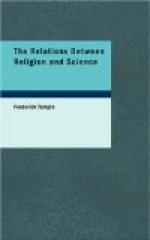What conception of foresight and purpose can rise above that which imagines all history gathered as it were into one original creative act from which the infinite variety of the Universe has come and more is coming even yet?
And yet again, it is a common objection to Paley’s and similar arguments that, in spite of all the tokens of intelligence and beneficence in the creation, there is so much of the contrary character. How much there is of apparently needless pain and waste! And John Stuart Mill has urged that either we must suppose the Creator wanting in omnipotence or wanting in kindness to have left His creation so imperfect. The answer usually given is that our knowledge is partial, and, could we see the whole, the objection would probably disappear. But what force and clearness is given to this answer by the doctrine of Evolution which tells us that we are looking at a work which is not yet finished, and that the imperfections are a necessary part of a large design the general outlines of which we may already trace, but the ultimate issue of which, with all its details, is still beyond our perception! The imperfections are like the imperfections of a half-completed picture not yet ready to be seen; they are like the bud which will presently be a beautiful flower, or the larva of a beautiful and gorgeous insect; they are like the imperfections in the moral character of a saint who nevertheless is changing from glory to glory.




